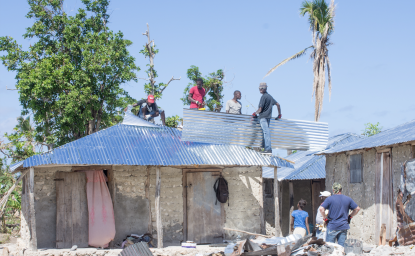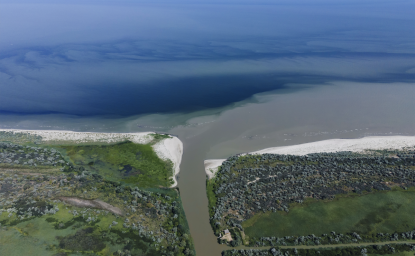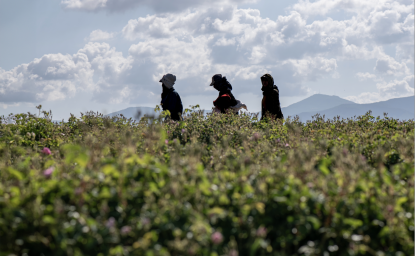Overexploiting natural resources—through unsustainable logging, unregulated mining, or overfishing—can spur instability and conflict. Therefore, "natural resource-based institutions
are critical for conflict mitigation," said Masego Madzwamuse of the World Conservation Union (IUCN), at one of six meetings sponsored by the Environmental Change and Security Program on "New Horizons at the Nexus of Conflict, Natural Resources, and Health." A wide range of participants—including field practitioners, policymakers, donors, academics, and community stakeholders—focused on developing practical approaches to improving environmental management and reducing conflict.
This series was jointly funded by three different USAID offices—Natural Resources Management, Population and Reproductive Health, and Conflict Management and Mitigation—and also received technical support from USAID's Asia, Middle East, and Africa bureaus. "This collaboration is unprecedented," said ECSP Director Geoffrey D. Dabelko. "It takes these kinds of cross-silo collaborations to deal with today's complex world."
Natural Resources and Extractive Industries
The first event in this series, in January 2008, examined the role of extractive industries in preventing and mitigating conflict. The extraction of a country's natural resources—whether oil, gas, or minerals—can spur corruption, environmental degradation, and the unequal distribution of economic benefits, leading to instability or conflict.
During the past several decades, many academics, NGOs extractive industry companies, and policymakers have come to recognize that "discovering oil and
mineral resources in poor or transitional countries was going to lead to as many problems in terms of development and stability in those countries as it was going to lead to positive change and development," said Wilson Center Public Policy Scholar Jill Shankleman (see Scholar Spotlight). She believes conflict can be prevented by ensuring local communities benefit from the mining or drilling taking place. She said, "It is just not going to be politically sustainable to continue to develop energy resources in poor countries for export when people living around the sites don't have electricity."
Conservation International's Assheton Carter noted that environmental and social considerations have a far greater chance of influencing a project's design in its early planning stages. He cited a case in Peru where, in 2004, a mining company created a multimillion dollar trust fund for the local community in return for rights to explore an area for a potential copper mine. Yet very little of the fund has been used, due to wrangling among local, regional, and national governments and the community over how to spend it.
Carter believes that extractive industry companies are becoming increasingly aware of, and responsible for, the impacts of their projects. The companies his organization works with "realize that they do have a responsibility to act as civilized neighbors and not to shirk difficult situations," he said.
Sustaining the Environment after Disaster
"Unfortunately, disasters are a growth industry," said Anita Van Breda of the World Wildlife Fund at a November 12 meeting on sustaining natural resources during post-disaster relief. But a disaster's environmental impact is not a priority for first responders, who are focused on saving as many lives as quickly as possible. Environmentalists, who tend to think in terms of decades and generations, can find it difficult to communicate effectively with aid workers. "You give a 30-page report and it's not going to be read and there's going to be no action," said Charles Kelly of University College London.
Natural disasters often strike communities with environments that have been damaged by deforestation, overfishing, conflict, or other problems, so Van Breda argued post-disaster reconstruction should aim to improve upon pre-disaster environmental conditions. Since the tsunami hit Southeast Asia in 2005, WWF has worked with the American Red Cross and its partners to enhance livelihoods, water and sanitation, shelter, and disaster preparedness in the region. "The environment and humanitarian issues are integrated," she said, "and we need to learn how to work together more successfully."
When not implemented properly, environmental assistance can lead to renewed conflict. For example, Kelly recounted how an NGO helped Sudanese refugees in Chad plant trees not knowing the neighboring tribes viewed planting trees as claiming ownership of the land. Several people died in the ensuing conflict. Kelly emphasized that resolving environmental issues ultimately requires competent national-level governance.
Population and Conservation
"Protected areas are the backbone of biodiversity conservation strategies," so it is critical to examine how population growth is affecting them, said Justin Brashares of the University of California, Berkeley, at the October 22 meeting "Fertile Fringes: Population Growth at Protected-Area Edges." George Wittemyer of Colorado State University explained that rapid population growth near protected areas—which limit human activity within their boundaries—helps drive deforestation, threatening biodiversity.
Brashares and Wittemyer published research in Science examining population's impact on protected areas in Africa and Latin America—excluding potentially confounding urban areas. They compared population growth in a 10-kilometer "buffer zone" surrounding each protected area with average rural population growth for that country from 1996-2000. In 245 of the 306 parks they examined—and 38 of the 45 countries—population growth at protected-area edges was significantly higher than average national rural population growth.
Brashares and Wittemyer attributed these higher population growth rates to people migrating to the edges of protected areas for better economic opportunities. Jason Bremner of the Population Reference Bureau agreed migration likely is driving higher population growth around protected areas, but questioned whether this migration was driven by conservation investments, such as the creation of protected areas.
Water and Land
A May 15th meeting in this series, "Troubled Waters," addressed the tensions that fisheries can precipitate. "We have to deal with these challenges of feeding people and their livelihoods if we want to think about the conservation aspects" of marine ecosystem management, said Chip Barber of USAID.
Richard Pollnac, a professor at the University of Rhode Island, explained that many Southeast Asians rely heavily on fish for dietary protein and income generation. But rapid population growth, combined with open access to most fisheries, has severely depleted fish stocks and damaged coral reefs in the region. Dwindling fish populations have reduced incomes, lowered food security, and increased poverty. As the number of fish declines, explained Pollnac, "the competition increases
We've got competition of migrants versus locals. We've got competition concerning small-scale versus commercial fisheries."
Barber said, "a long legacy of mistrust between the central government and people in local communities" is often an obstacle to successful co-management of fisheries. A 2007 study that Pollnac and his colleagues published in Marine Policy found that co-management of fisheries in Vietnam, the Philippines, and Indonesia did significantly reduce conflict. Pollnac cautioned, "the larger the population you're dealing with, the more difficult it is to get people to agree and to develop a co-management scheme."
A February 28 meeting examined how community-based natural resource management (NRM) of land-based resources can strengthen local governance and help prevent violent conflict from erupting. The mismanagement of land or other natural resources can spur instability or conflict: For instance, the creation of protected areas can displace people, prompting migration; profits from mineral extraction can be inequitably distributed, leading to protest or unrest; or farmers can compete for scarce arable land.
Local NRM organizations, such as community forest user groups and wildlife conservancies, can help improve governance and prevent conflict at the local level, but require external support, said David Bray of Florida International University. "For community-based conservation to happen, you have to have supporting actors, structures from all levels of national and international society, government, civil society. It's a multi-scale process."
At the April 23 meeting "Land Tenure and Property Policies in East Africa," Peter Hetz of ARD, Inc. said, "Insecure land tenure and property rights and the inequitable access to land and natural assets are two of the leading triggers of violent conflict, population displacement, the over-exploitation of natural resources, and political instability throughout eastern Africa." Hetz and USAID's Gregory Myers explored how imprecise or inequitable systems of land tenure and property rights have helped precipitate conflict in Northern Uganda, Kenya, and Southern Sudan, and warned that lack of attention to these crucial issues will foster further violence in those volatile countries.
Myers said, "We must support legal and institutional reforms that give the most people the greatest number of opportunities to access resources and secure their rights."
ECSP's Rachel Weisshaar contributed to this story.
Related Links




